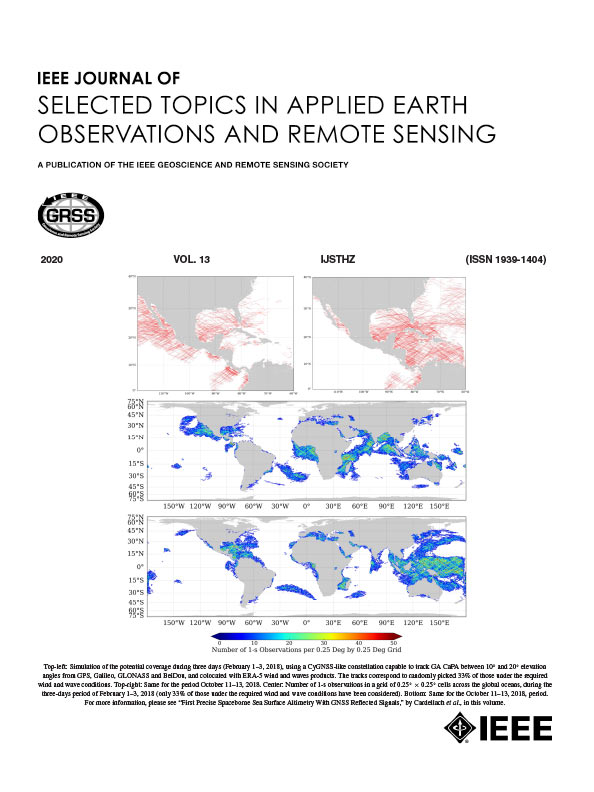Extraction of Raft Aquaculture in SDGSAT-1 Images via Shape Prior Segmentation Network
IF 4.7
2区 地球科学
Q1 ENGINEERING, ELECTRICAL & ELECTRONIC
IEEE Journal of Selected Topics in Applied Earth Observations and Remote Sensing
Pub Date : 2025-03-28
DOI:10.1109/JSTARS.2025.3555645
引用次数: 0
Abstract
Reliable extraction of raft aquaculture areas from high-resolution remote sensing data is vital for the sustainable development of coastal zones. Despite the success of semantic segmentation, challenges remain due to adhesion effects, weak and seasonal spectral signals against complex dynamic backgrounds, and limited labeled training data for robust and generalizable models. To overcome these challenges, this article proposes a shape prior segmentation network for the extraction of raft aquaculture areas from Sustainable Development Science Satellite-1 (SDGSAT-1) images. Based on the encoder-decoder framework of a U-shaped network, the method incorporates a shape prior module that flexibly integrates with the backbone network. This module combines global shape priors, offering coarse shape representations to model global contexts, and local shape priors, providing fine shape information to enhance segmentation accuracy while reducing dependency on learnable prototypes. By leveraging shape priors, the network can achieve satisfactory segmentation reliability, efficiency, and faster learning during training. Extensive experiments validate the proposed methodology, achieving an accuracy of 98.26%, a mean pixel accuracy of 88.26%, and a mean intersection over union of 85.16% .基于形状先验分割网络的SDGSAT-1图像筏养殖提取
从高分辨率遥感数据中可靠地提取筏养殖区域对海岸带的可持续发展至关重要。尽管语义分割取得了成功,但由于粘附效应、复杂动态背景下微弱的季节性光谱信号以及用于鲁棒和可泛化模型的有限标记训练数据,仍然存在挑战。为了克服这些挑战,本文提出了一种形状先验分割网络,用于从可持续发展科学卫星1号(SDGSAT-1)图像中提取筏形养殖区。该方法基于u型网络的编解码器框架,采用形状优先模块与骨干网灵活集成。该模块结合了全局形状先验和局部形状先验,前者提供粗糙的形状表示来建模全局上下文,后者提供精细的形状信息来提高分割精度,同时减少对可学习原型的依赖。通过利用形状先验,网络可以在训练过程中获得令人满意的分割可靠性、效率和更快的学习速度。大量的实验验证了所提出的方法,实现了98.26%的准确率,88.26%的平均像素精度和85.16%的平均相交比并。
本文章由计算机程序翻译,如有差异,请以英文原文为准。
求助全文
约1分钟内获得全文
求助全文
来源期刊
CiteScore
9.30
自引率
10.90%
发文量
563
审稿时长
4.7 months
期刊介绍:
The IEEE Journal of Selected Topics in Applied Earth Observations and Remote Sensing addresses the growing field of applications in Earth observations and remote sensing, and also provides a venue for the rapidly expanding special issues that are being sponsored by the IEEE Geosciences and Remote Sensing Society. The journal draws upon the experience of the highly successful “IEEE Transactions on Geoscience and Remote Sensing” and provide a complementary medium for the wide range of topics in applied earth observations. The ‘Applications’ areas encompasses the societal benefit areas of the Global Earth Observations Systems of Systems (GEOSS) program. Through deliberations over two years, ministers from 50 countries agreed to identify nine areas where Earth observation could positively impact the quality of life and health of their respective countries. Some of these are areas not traditionally addressed in the IEEE context. These include biodiversity, health and climate. Yet it is the skill sets of IEEE members, in areas such as observations, communications, computers, signal processing, standards and ocean engineering, that form the technical underpinnings of GEOSS. Thus, the Journal attracts a broad range of interests that serves both present members in new ways and expands the IEEE visibility into new areas.

 求助内容:
求助内容: 应助结果提醒方式:
应助结果提醒方式:


